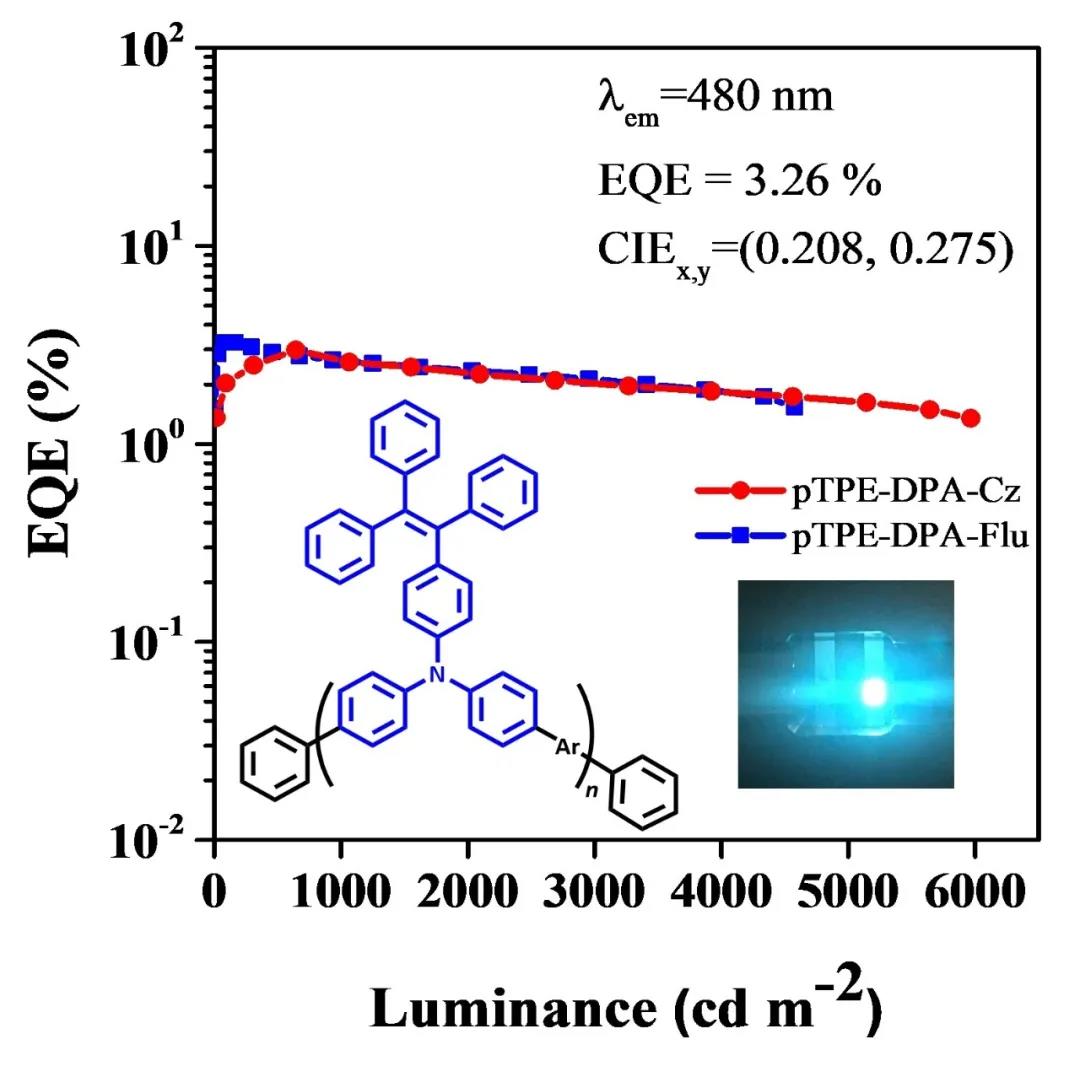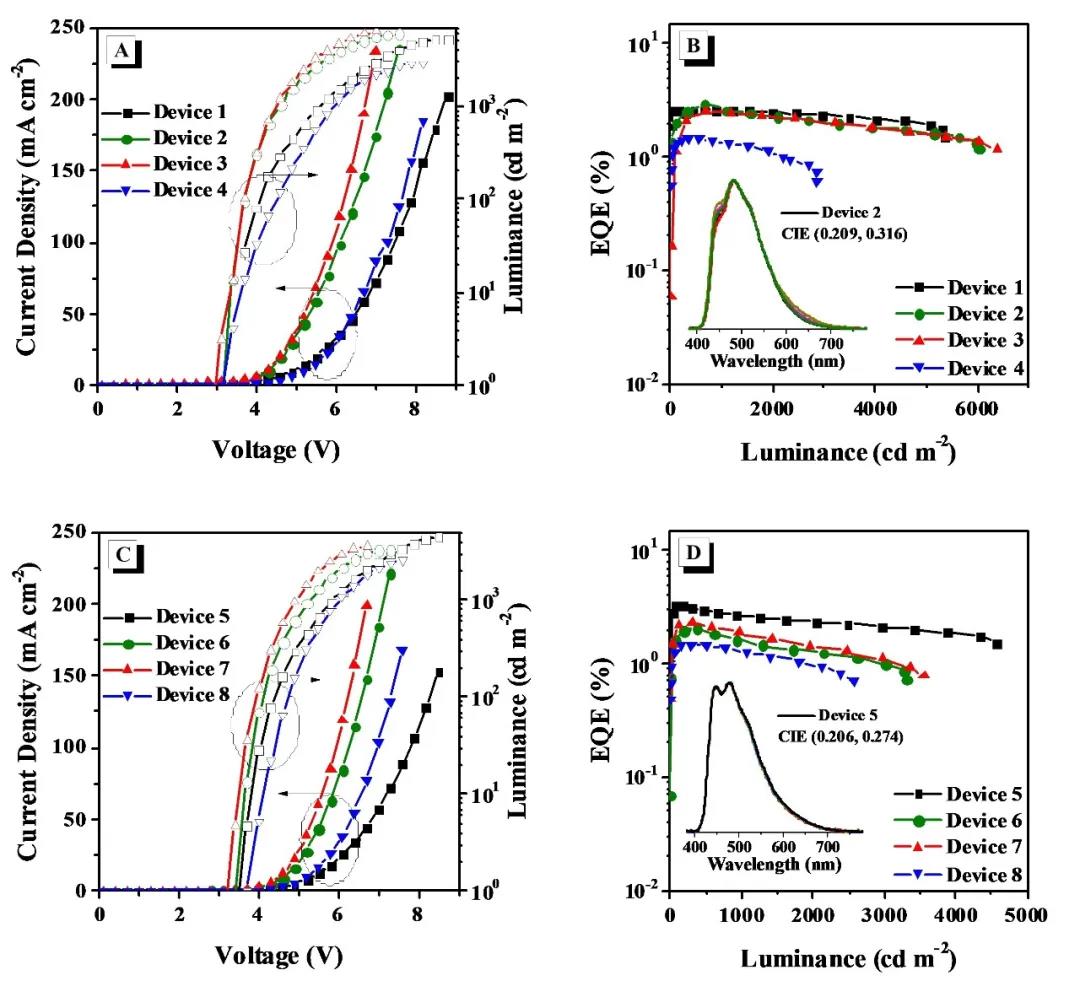
hotline:
17715390137
Tel/Wechat:
18101240246 (Technology)
0512-68565571
Email:mxenes@163.com (Sales Engineer)bkxc.bonnie@gmail.com
Scan the code to follow or search the official account on WeChat:
2D Materials Fronrier After paying attention,
click on the lower right corner to contact us,
Enter enterprise WeChat.
Professional Services Online

Organic electroluminescence devices have experienced nearly 30 years of development and have now entered the stage of commercialization. Among them, polymer electroluminescence devices (PLEDs) that can be prepared by solution processing have attracted much attention because of their simple preparation process and low cost. However, the conventional light-emitting polymer used in the light-emitting layer usually weakens the fluorescence in the aggregated state, that is, the phenomenon of aggregation leading to fluorescence quenching (ACQ) occurs. Because such materials are usually made into thin films in practical applications, their use in PLEDs is restricted, and the prepared devices generally have the problem of high efficiency roll-off. Aggregation-induced luminescence (AIE) polymers can solve the problem of light-emitting quenching of solid-state thin films, and have excellent properties such as easy processing, easy functionalization, diverse structures, and good thermal stability. However, PLEDs based on AIE polymers are currently There is less research and device performance still needs to be improved. And combining the respective advantages of AIE and PLEDs is one of the effective strategies to solve the problem of high device efficiency roll-off.
Recently, Professor Qin Anjun from the team of Academician Tang Benzhong of South China University of Technology and other researchers designed and synthesized two AIE polymers, pTPE-DPA-Cz and pTPE-DPA-Flu, and worked with Professor Ma Dongge‘s team to prepare solutions based on these two AIEs. Polymer‘s high-efficiency, low-roll-off PLEDs (Figure 1).

Figure 1: AIE polymers pTPE-DPA-Cz and pTPE-DPA-Flu and their device effects
In this work, TPE-DPA was introduced as the AIE moieties to copolymerize carbazole and fluorene with long alkyl chains to prepare polymers pTPE-DPA-Cz and pTPE with good solubility and weight average molecular weights of 19,000 and 24000, respectively -DPA-Flu (Figure 2). The polymer obtained has good thermal stability, with thermal decomposition temperatures (Td) of 510 and 442 ° C, respectively; and glass transition temperatures (Tg) of 193 and 152 ° C, respectively.

Figure 2: Synthesis of polymers pTPE-DPA-Cz and pTPE-DPA-Flu
The polymers pTPE-DPA-Cz and pTPE-DPA-Flu have very weak fluorescence emission in the tetrahydrofuran solution, and their fluorescence quantum yields are only 0.4 and 1.5%, respectively. In the (doped) film state, their fluorescence quantum yield The rates increased to 63.3 and 59.7%, respectively, which proved that the obtained polymer had obvious AIE properties. Experiments with poor solvent water in THF solution further verified the AIE properties of the two polymers (Figure 3).
 Figure 3: Fluorescence emission spectra of polymers (A) pTPE-DPA-Cz and (B) pTPE-DPA-Flu in tetrahydrofuran / water mixed solutions with different water contents; (C) Molar absorption intensity corresponding to different water contents I / I0 change curve. Inset is a photo of two polymer molecules under UV light (365 nm) excitation (water volume percentages are 0 and 99%, respectively)
Figure 3: Fluorescence emission spectra of polymers (A) pTPE-DPA-Cz and (B) pTPE-DPA-Flu in tetrahydrofuran / water mixed solutions with different water contents; (C) Molar absorption intensity corresponding to different water contents I / I0 change curve. Inset is a photo of two polymer molecules under UV light (365 nm) excitation (water volume percentages are 0 and 99%, respectively)
In view of the good thermal stability, excellent film-forming properties, and high fluorescence quantum yield of pTPE-DPA-Cz and pTPE-DPA-Flu, AIE polymer electroluminescence was prepared by solution processing as a light-emitting layer material. Device. The structure of the prepared device is as follows: ITO / PEDOT: PSS (50 nm) / EMLs / TmPyPB (40 nm) / LiF (1 nm) / Al (120 nm), where ITO is used as the anode, and PEDOT: PSS and LiF are used as holes And electron injection layer, TmPyPB serves as the electron transport layer, and Al serves as the cathode. Among them, the light-emitting layers of devices 1-3 are CBP-doped films (55 nm) with pTPE-DPA-Cz content of 5, 10, and 30 wt%, and the light-emitting layers of device 4 are pTPE-DPA-Cz (60 nm). ; The light-emitting layers of devices 5-7 are CBP-doped films (60 nm) with pTPE-DPA-Flu contents of 5, 10, and 30 wt%, and the light-emitting layers of device 8 are pTPE-DPA-Flu (50 nm).
Among the doped devices prepared based on pTPE-DPA-Cz, device 2 showed the highest current efficiency (6.47 cd A-1), the highest power efficiency (4.73 lm W-1), and the highest external quantum efficiency (2.98%). It is worth noting that when the device brightness reaches 500 cd m-2, its current efficiency, power efficiency and external quantum efficiency can still maintain the levels of 6.02 cd A-1, 4.53 lm W-1 and 2.77%, indicating that the period Has a lower efficiency roll-off. In addition, the highest current efficiency, power efficiency, and external quantum efficiency of the non-doped device 4 can reach 3.69 cd A-1, 2.28 lm W-1, and 1.46%, respectively. When the device brightness reaches 500 cd m-2, these values can still reach 3.67 cd A-1, 2.13 lm W-1 and 1.44% also showed lower efficiency roll-off. In devices 5-8 prepared based on pTPE-DPA-Flu, similar results as those in devices 1-4 can also be observed, all showing lower efficiency roll-off and excellent device stability. (Figure 4)

Figure 4: (A) and (C) are the current density-voltage-brightness curves for devices 1-8; (B) and (D) are the external quantum efficiency-brightness curves for devices 1-8. Inset is the electroluminescence spectra of devices 2 and 5.
This work provides a feasible way to prepare high-efficiency, low-roll-off polymer electroluminescent devices through solution processing, and also illustrates the use of AIE polymers as the light-emitting layer material to prepare high-efficiency, low-roll-off polymer electroluminescent devices. Light emitting devices are very promising strategies.
The first author of this work is Gu Jiabao.

| Reminder: Beijing Beike New Material Technology Co., Ltd. supplies products only for scientific research, not for humans |
| All rights reserved © 2019 beijing beike new material Technology Co., Ltd 京ICP备16054715-2号 |